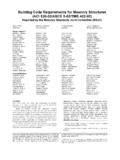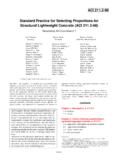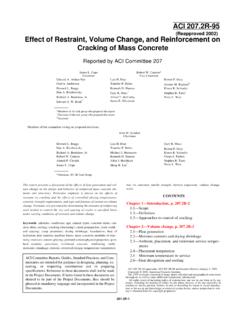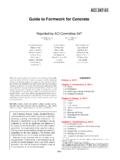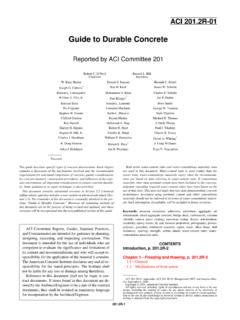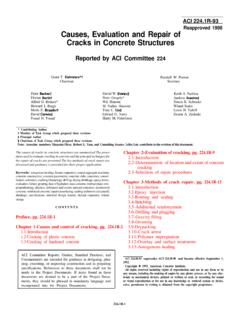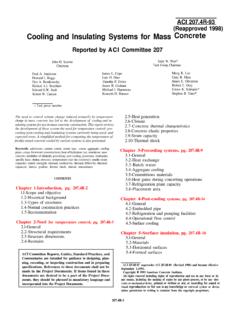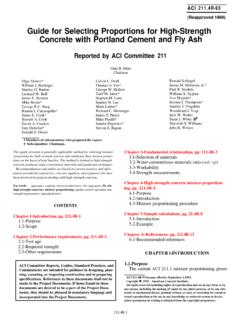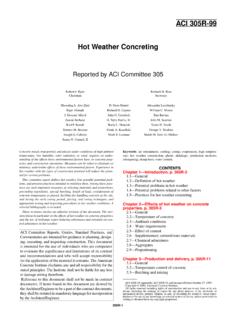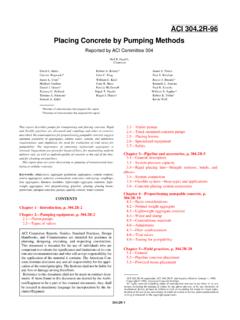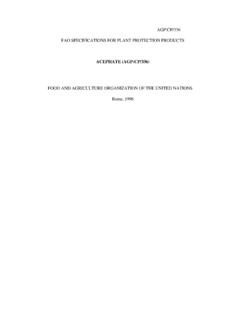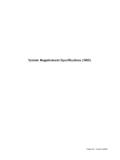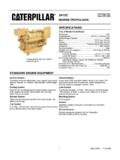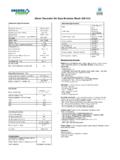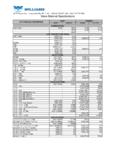Transcription of 117-R90 Commentary on Standard Specifications …
1 *Chairman during initial developement of this documentCopyright 1990, American Concrete rights reserved including rights of reproduction and use in any form or by anymeans, including the making of copies by any photo process, or by electronic ormechanical device, printed, written, or oral, or recording for sound or visual reproduc-tion or for use in any knowledge or retrieval system or device, unless permission inwriting is obtained from the copyright proprietors. ACI Committee Reports, Guides, Standard Practices, andCommentaries are intended for guidance in planning, design-ing, executing, or inspecting construction and in preparingspecifications. Reference to this document shall not bemade in the Project Documents.
2 If items found in thesedocuments are desired to be a part of the Project Documents,they shall be phrased in mandatory language and incorporatedin the Project Documents. 117R-1 This report is a Commentary on the Standard Specifications for Tolerancesfor Concrete Construction and Materials. It is intended to be used with ACI117 for clarity of interpretation and insight into the intent of the committeeregarding the application of the tolerances set forth : bending (reinforcing steels); building codes; concrete construc-tion; concrete piles; concretes; floors; formwork (construction); masonry;mass concrete; piers; precast concrete; prestressed concrete; reinforcingsteels, Specifications ; splicing; standards ; tolerances (mechanics).
3 INTRODUCTIONThis Commentary pertains to Standard Specifications forTolerances for Concrete Construction and Materials (ACI-117). The purpose of the report is to provide graphic andwritten interpretations for the specification and its structure is exactly level, plumb, straight, and , such perfection is not necessary. Tolerances area means to establish permissible variation in dimension andlocation, giving both the designer and the contractor param-eters within which the work is to be performed. They are themeans by which the designer conveys to the contractor theperformance expectations upon which the design is based orthe use of the project requires. Such specified tolerancesshould reflect design assumptions and project needs, beingneither overly restrictive nor lenient.
4 Necessity rather thandesirability should be the basis of selecting the title Standard Specifications for Tolerances forConcrete Construction and Materials (ACI 117) implies,the tolerances given are Standard or usual tolerances that ap-ply to various types and uses of concrete construction. Theyare based upon normal needs and common construction tech-niques and practices. Specific tolerances at variance with thestandard values can cause both increases and decreases in thecost of required degree of accuracy of performance dependson the interrelationship of several factors:Structural strength and function requirementsThe structure must be safe and strong, reflecting the designassumptions, and accurate enough in size and shape to do thejob for which it was designed and structure must satisfy the appearance needs or wishesof the owner and the feasibilityThe specified degree of accuracy has a direct impact on thecost of production and the construction method.
5 In general,the higher degree of accuracy required, the higher the cost ofobtaining of all componentsThe required degree of accuracy of individual parts can beinfluenced by adjacent units and materials, joint and connec-tion details, and the possibility of the accumulation of toler-ances in critical on Standard Specifications for Tolerances for Concrete Construction and Materials (ACI 117-90)ACI 117R-90 Reported by ACI Committee 117W. Robert LittleRussell S. FlingChairmanChairman, Editorial SubcommitteeS. Allen FaceAndrawos MorcosB. J. (Duke) PointerThomas C. HeistClark B. Morgan B. Stephan Jr.*Richard A. Kaden Harry M. Palmbaum Eldon TippingRoss MartinWilliam S.
6 PhelanCarl S. TogniPeter MezaJoe V. Williams, Jr. 117R-2 ACI COMMITTEE REPORTC onstruction techniquesThe feasibility of a tolerance depends on available crafts-manship, technology, and of materialsThe specified degree of accuracy for shrinkage and pre-stressed camber should recognize the degree of difficulty ofpredetermining deflection due to shrinkage and are cautioned to use finish and architectural de-tails that are compatible with the type and anticipated meth-od of construction. Finish and architectural details usedshould be compatible with the concrete tolerances which conditionsUnique job situations and conditions must be designer must specify and clearly identify those itemsthat require either closer or more lenient tolerances as theneeds of the project agreed-upon control points and bench marksmust be provided as reference points for measurements to es-tablish the degree of accuracy of items produced and for ver-ifying the tolerances of the items produced.
7 Control pointsand bench marks should be established and maintained in anundisturbed condition until final completion and acceptanceof the document referencesACI specification documents The following AmericanConcrete Institute documents provide mandatory require-ments for concrete construction and may be referenced in theProject Documents:ACI 117 Standard Specifications for Tolerancesfor Concrete Construction and MaterialsACI 301 Specifications for Structural Concrete forBuildingsACI specification for Concrete Masonry ConstructionACI informative documents ACI Committee Reports,Guides, Standard Practices, and Commentaries are intendedfor guidance in designing, planning, executing, or inspectingconstruction, and in preparing plans and Specifications .
8 Ref-erence to these Reports, Guides, and Standard Practicesshould not be included in the Project Documents. If the Ar-chitect/Engineer desires to include items found in these ACIdocuments in the Project Documents, they should be re-phrased in mandatory language and incorporated into theProject documents of the following American Concrete Insti-tute Committees cover practice, procedures, and state-of-the-art guidance for the categories of construction as building ACI 302, 303, 304, 318, 347 Special structures ACI 307, 313, 316, 325, 332, 334,344, 345, 349, 350, 357, 358 Precast construction ACI 347 Masonry construction ACI 531 Materials ACI 211, 223, 302, 304, 315, 318,531, 543 TABLE OF CONTENTSI ntroduction, p.
9 117R-1 Section 1 General requirements, p. 117R-2 Section 2 Materials, p. 117R-4 Section 3 Foundations, p. 117R-5 Section 4 Cast-in-place concrete for buildings, p. 117R-5 Section 5 Precast concrete, p. 117R-8 Section 6 Masonry, p. 117R-10 Section 7 Cast-in-place, vertically slipformed structures, p. 117R-10 Section 8 Mass concrete structures other than build-ings, p. 117R-10 Section 9 Canal lining, p. 117R-10 Section 10 Monolithic siphons and culverts, p. 117R-10 Section 11 Cast-in-place bridges, p. 117R-10 Section 12 Pavement, p. 117R-10 Section 13 Chimneys and cooling towers, p. 117R-11 Section 14 Cast-in-place nonreinforced pipe, p. 117R-11 Section 15 References, p. 117R-11 SECTION 1 GENERAL REQUIREMENTS DefinitionsBowing See Fig.
10 See Fig. alignment See Fig. alignment See Fig. alignment See Fig. alignment See Fig. See Fig. alignment, lateral alignment, and vertical alignmentare used to establish a tolerance envelope within which per-missible variations can occur. Relative alignment, in addi-tion to designating allowable relative displacements ofelements, is used to determine the rate of change of adjacentpoints (slope tolerance) occurring within the tolerance enve-lope. In this fashion the slope and smoothness of surfacesand lines within a tolerance envelope are controlled. Abrupt 117R-3 TOLERANCESFig. Wa r p i n gFig. Lateral alignmentFig. FlatnessFig. Vertical alignmentFig. Relative alignmentFig.
